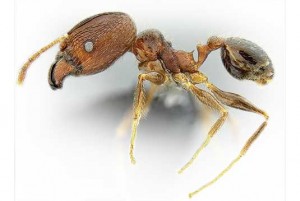
An adult big-headed ant. Photo: Eli Sarnat, PIAkey, USDA APHIS Identification Technology Program (ITP)
Big-headed ants (Pheidole Spp.) are multiple-queen menaces that foul food and form formicarcia (colonies), which causes structural strife for innocent inhabitants.
Description: Workers (1/16- to 1/8-in.) are distinguished by dimorphism, or two sizes: a heart-shaped/indented head and a small head. They have 12-segmented antennae with short scapes and three-segmented clubs, thoracic spines, and a two-node pedicel. Coloring is light brown to reddish brown or nearly black.
Life Cycle: Complete metamorphosis, as well as polygynic (multiple queens). Mature colonies radiate into supercolonies with satellite colonies. Winged reproductives swarm in summer.
Habitat: Rotting trees, wood piles, under static objects and slabs, and in soil.
Food: Insects, seeds and honeydew. When indoors, they forage on meat, grease and breads.
Range: New York to Nebraska, south to Florida, west to Arizona.
Significance: Known to bite. They can host tapeworms from wild and domestic fowl, and form strong trails to exploited food sources.
Dr. Stuart Mitchell, D.O., Ph.D., M.P.H., B.C.E., a board-certified physician and entomologist, is principal technical specialist for PestWest Environmental, as well as PMP’s Technical Editor. He can be reached at docmitchell@northcoastmedia.net or 515-333-8923.
Leave A Comment